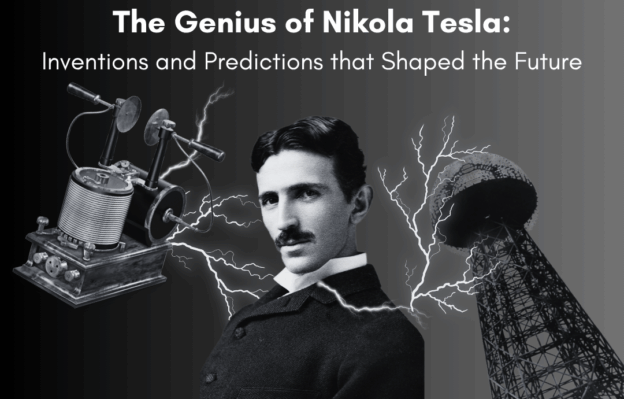Nikola Tesla made revolutionary contributions to technology, including the AC induction motor, Tesla coil, wireless communication, and remote control. He accurately predicted future innovations like wireless communication, renewable energy, and automation, envisioning concepts similar to modern smartphones. However, he did not foresee advancements such as quantum computing, genetic engineering, space exploration, and virtual reality. Tesla’s work continues to inspire and influence contemporary science and technology, solidifying his legacy as a pioneering inventor and visionary.
Introduction
Nikola Tesla, often hailed as one of the greatest inventors and visionaries of all time, made groundbreaking contributions to science and technology. His inventions laid the foundation for many modern technological advancements, and his predictions offered glimpses into the future of human progress. This article explores Tesla’s most significant inventions in chronological order, highlights his technological predictions, and examines the advancements he did not foresee.
Nikola Tesla’s Inventions in Chronological Order
- Induction Motor (1887-1888): Alternating current (AC) induction motor.
- Tesla’s development of the alternating current (AC) induction motor revolutionized the field of electrical engineering. Unlike direct current (DC) motors, AC motors were more efficient and capable of transmitting power over long distances, paving the way for the widespread adoption of AC power systems.
- Polyphase AC Systems (1888): System for generating and distributing alternating current.
- Tesla Coil (1891): Resonant transformer circuit for high-voltage, low-current, high-frequency AC electricity.
- The Tesla coil is a resonant transformer circuit that produces high-voltage, low-current, high-frequency alternating-current electricity. It was fundamental in advancing radio technology and electrical experimentation, showcasing Tesla’s ability to harness and manipulate electrical energy.
- Shadowgraph (1896): Early form of X-ray imaging.
- Radio (1893): Demonstration of wireless communication principles.
- Although Guglielmo Marconi is often credited with the invention of the radio, Tesla demonstrated the principles of wireless communication years earlier. In 1893, he presented a public demonstration of radio waves, laying the groundwork for modern wireless communication.
- Fluorescent Lighting (1893): Early development and demonstration of fluorescent lamps.
- Remote Control (1898): The first remote-controlled boat using radio waves.
- Tesla invented the first remote-controlled boat, showcasing his pioneering work in radio waves and wireless technology. This invention foreshadowed the development of modern remote control systems used in various applications, from consumer electronics to military technology.
- Tesla’s Oscillator (1898): Mechanical oscillator for generating electric current.
- Hydroelectric Power Plant (1895): Design and implementation at Niagara Falls.
- Wireless Power Transmission (1899): Experiments and the creation of the Wardenclyffe Tower.
- Tesla’s experiments with wireless power transmission culminated in the creation of the Wardenclyffe Tower. Although the project was never completed, Tesla envisioned a world where electricity could be transmitted wirelessly across great distances, eliminating the need for traditional power lines.
- Bladeless Turbine (1906): Turbine utilizing smooth, disk-shaped rotors.
- Also known as the Tesla turbine, this invention utilized smooth, disk-shaped rotors instead of blades to harness fluid dynamics for energy production. Although it was not widely adopted at the time, the bladeless turbine concept remains influential in engineering and fluid dynamics.
- Magnifying Transmitter (1907): Enhanced version of the Tesla coil for wireless power.
- Neon Lamps (1910): Development of neon lighting technology.
- Tesla’s experiments with high-voltage currents led to the development of neon lighting, which became a popular form of illumination and artistic expression. His work in this area demonstrated the practical applications of his innovations in everyday life.
- Tesla Valve (1920): One-way valve with no moving parts for fluid dynamics.
- Tesla’s Teleforce (1930s): Conceptual particle-beam weapon.
These inventions, listed chronologically, highlight the breadth and depth of Tesla’s contributions to modern technology.
Technological Predictions by Tesla
- Wireless Communication: Tesla predicted a future where information could be transmitted wirelessly around the globe. He foresaw a “global brain” of interconnected devices, which aligns closely with today’s internet and wireless communication networks.
- Renewable Energy: Tesla advocated for harnessing natural energy sources, such as solar and wind power. He envisioned a future where renewable energy would replace fossil fuels, a concept that has gained significant traction in the 21st century.
- Automation and Robotics: Tesla predicted the rise of automated machines and robots, suggesting that they would perform tasks traditionally done by humans. This prediction has manifested in the form of modern robotics and artificial intelligence.
- Smartphones and Wireless Devices: Tesla imagined a world where individuals could carry a small device to communicate wirelessly, access information, and control various functions. This vision closely resembles the modern smartphone.
Technological Advancements Not Foreseen
- Quantum Computing: Tesla’s focus was primarily on electrical engineering and mechanical inventions. He did not predict the development of quantum computing, which leverages quantum mechanics to perform computations far beyond the capabilities of classical computers.
- Genetic Engineering and Biotechnology: Tesla’s predictions did not encompass the advancements in genetic engineering and biotechnology, fields that have revolutionized medicine, agriculture, and environmental science.
- Space Exploration: While Tesla had grand visions for technology on Earth, he did not specifically predict the extent of space exploration achieved in the 20th and 21st centuries, including human spaceflight, Mars exploration, and the development of space stations.
- Virtual Reality and Augmented Reality: Tesla did not foresee the emergence of virtual reality (VR) and augmented reality (AR) technologies, which have transformed entertainment, education, and various industries by creating immersive digital experiences.
Conclusion
Nikola Tesla’s inventions and predictions have had a profound impact on the modern world. His pioneering work in electrical engineering, wireless communication, and renewable energy set the stage for many technological advancements that define contemporary life. While Tesla did not foresee every technological development, his vision and innovations continue to inspire and shape the future of science and technology. Tesla’s legacy as a brilliant inventor and futurist remains unparalleled, reflecting his enduring influence on the progress of humanity.
